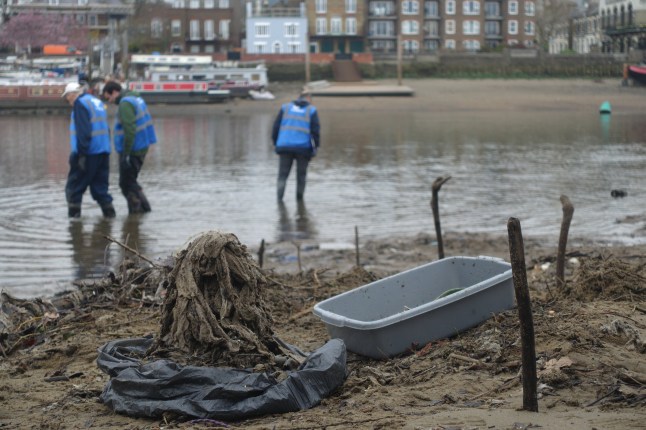To view this video please enable JavaScript, and consider upgrading to a web
browser that
supports HTML5
video
An unsuspecting metal detectorist partaking in his hobby uncovered a huge hoard of Iron Age items buried in two ditches.
Peter Heads made the astonishing discovery back in 2021, and archaeologists have been working to stabilise and examine the more than 800 items ever since.
Its existence has been announced today by Durham University and Historic England, who helped pay for its excavation with a £120,000 grant.
Previously, it was thought the wealth and power in pre-Roman England was concentrated in the south of the country – but this huge hoard of valuables which were apparently deliberately thrown into a ditch shows that may not be true.
The hoard was found in Melsonby, a village about a mile away from Stanwick which was the main base of the Brigantes, a tribe which ruled most of what is now Yorkshire in pre-Roman times.
Excavated in 2022 by Durham University’s archaeology team, the objects have been stabilised and recorded during the legal treasure process, which has now ended.
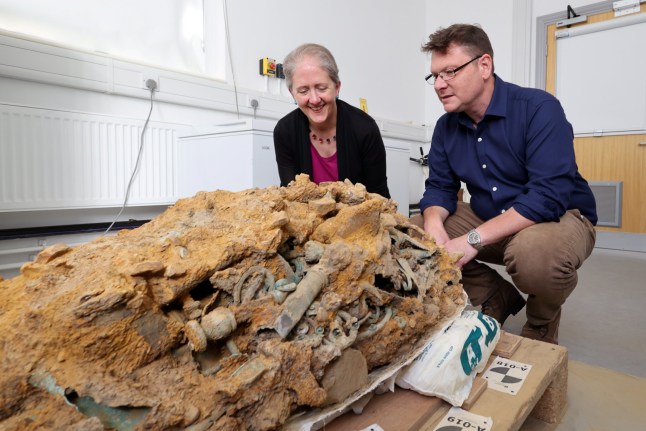
The Yorkshire Museum says it fears the items could be sold off to private collectors and has launched a fundraising campaign to keep, conserve and exhibit the hoard for years to come.
Professor Tom Moore, head of archaeology at the university, was one of the first people called to the site and described it as a ‘once-in-a-lifetime discovery’.
He explained: ‘The Melsonby Hoard is of a scale and size that is exceptional for Britain and probably even Europe.
‘Unusually it includes lots of pieces of vehicles and items such as the wine mixing bowl which is decorated in both Mediterranean and Iron Age styles.
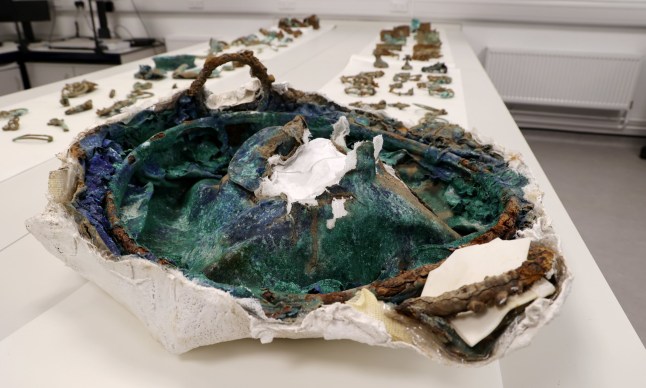
‘Whoever originally owned the material in this hoard was probably a part of a network of elites across Britain, into Europe and even the Roman world.
‘The destruction of so many high-status objects, evident in this hoard, is also of a scale rarely seen in Iron Age Britain and demonstrates that the elites of northern Britain were just as powerful as their southern counterparts.
What was found in the Melsonby Hoard?
The Melsonby Hoard, which lay untouched in two ditches near the North Yorkshire village of that name since the middle of the 1st century, comprises more than 800 items including partial remains of wagons, ceremonial spears and pony harnesses.
Vehicle components, for which it is hard to find parallels in Britain, include the partial remains of more than seven four-wheeled wagons or two-wheeled chariots.
There were elaborate harnesses for at least 14 ponies, three ceremonial spears and two ornate cauldrons or vessels – one lidded and likely used as a wine mixing bowl.
Some harness pieces were adorned with Mediterranean coral and coloured glass, and are larger than ones typically found here.
While some items look like those previously found in Britain, others better match those already discovered on the continent, which suggests whoever left them had long-distance connections.
Iron tyres, which were fitted to the outside of wooden wheels, had been intentionally bent out of shape and a large amount of the material had been ritualistically burnt or broken – rather than just smashed.
Prof Moore, who said research was at a very early stage, believed this might have been a symbolic process of people showing how wealthy and powerful they were.
‘Whoever is doing this is incredibly wealthy and it challenges the idea that northern Britain was a backwater, when it clearly was not.
‘It has connections to continental Europe and the Roman Empire.
‘It shows they are of the same status, if not more powerful than the elites in southern Britain.’
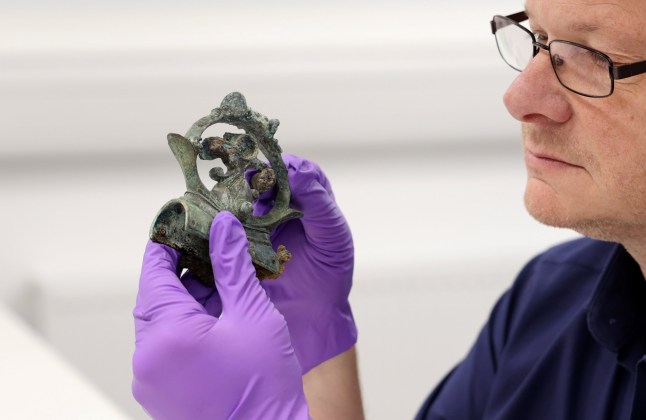
Peter Heads had simply been scanning a field in Melsonby, with the landowner’s permission, when he stumbled across the hoard.
The Melsonby Hoard has been valued at around £254,000 – but its value is much more than financial as Duncan Wilson, chief executive of Historic England, called it ‘one of the most important and exciting Iron Age period discoveries made in the UK’.
The two deposits, one much larger than the other, were excavated in different ways – and it took two months to fully excavate them.
The larger deposit was examined on site, slowly and painstakingly excavated as several of the hundreds of items had stuck together over the years.
Some items from the first ditch will soon be put on display at The Yorkshire Museum.
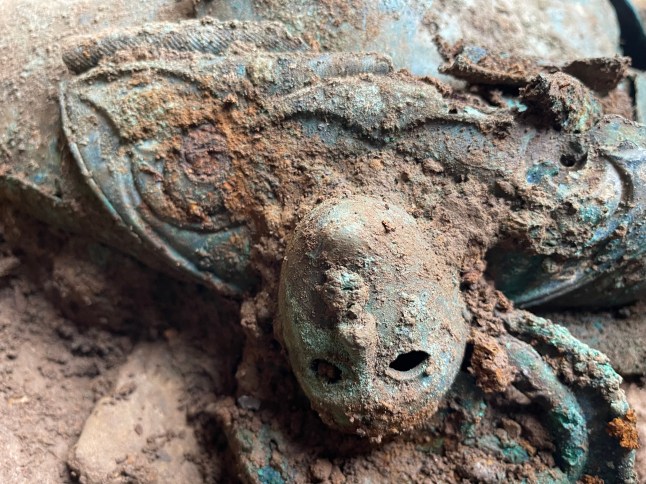
The smaller part of the horde had become a solid mass of metal objects and soil, so it was extracted as a whole and X-rayed using a large scanner at Southampton University.
The second part will be kept as a block to preserve the items which were hidden inside for hundreds of years.
Mr Wilson added: ‘The Melsonby Hoard sheds new light on Iron Age life in the north and Britain, but it also demonstrates connections with Europe.
‘Its proximity to the great Iron Age enclosure at Stanwick is an important factor in understanding its significance.
‘Historic England understood the importance of this find from the moment it was reported to us, and we’re thrilled we were able to provide grant support to allow its excavation and initial conservation.
‘Any member of the public viewing these new discoveries will feel a real sense of excitement and wonder.’
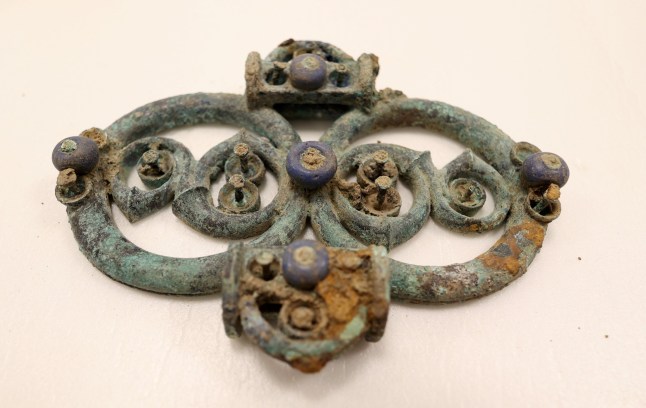
Throughout the years there have been dozens of Iron Age hoards discovered by metal detectorists and others, but none match up to the Melsonby Hoard when it comes to size and scale.
Many previous hoards were primarily made up of coins, called staters, or fragments of metal jewellery.
Major past hoards include:
- Polden Hill Hoard, found in Somerset in 1800, which contained about 90 metal artefacts including horse gear and trappings, segments of three shields, six brooches, three bracelets, and parts of two torcs (twisted gold jewellery for the neck or wrist)
- Stanwick Hoard, found in North Yorkshire in 1843, which contained about 180 metal artefacts including four sets of horse harnesses for chariots and a bronze horse head
- Llyn Cerrig Bach Hoard, found near Anglesey in 1942, which contained over 150 items of bronze and iron, including seven swords, six spearheads, fragments of a shield, part of a bronze trumpet, two gang chains, fragments of iron wagon tyres and horse gear, blacksmith’s tools, fragments of two cauldrons, and iron bars
- Salisbury Hoard, found in Wiltshire in 1988, which contained more than 600 objects, mostly miniature bronze versions of shields, tools, daggers and spearheads
- South Wight Hoard, found on the Isle of Wight in 2004, which contained 18 gold staters, 138 silver staters, 1 thin silver coin, 7 copper alloy coins of the Roman period, 2 bowl shaped silver ingots, 1 bowl shaped copper alloy ingot, 5 sherds of Iron Age pottery
Get in touch with our news team by emailing us at webnews@metro.co.uk.
For more stories like this, check our news page.

